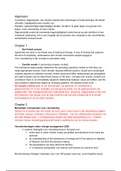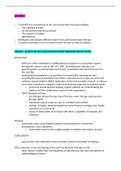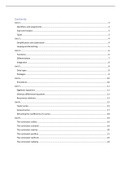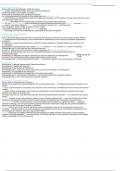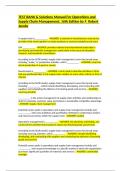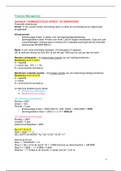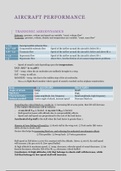H1: Inleiding ....................................................................................................................................................... 5
DEEL 1: ontwikkeling en afbaking van de discipline en de thoretische grondslagen ............................................. 6
H2: Prolegomena ................................................................................................................................................ 6
2.1 Paradimatische stijd en theorietische diversiteit in de communicatiewetenschappen .................................... 6
2.1.1 Het paradigmabegrip ................................................................................................................................ 6
2.1.1.1 Paradigma en paradigmawissel........................................................................................................ 6
2.1.1.2 Paradigma’s in de sociale wetenschappen ....................................................................................... 7
2.1.1.3 Paradigma’s in de communicatiewetenschappen ............................................................................ 7
2.1.2 Communicatiewetenschappelijke theorievorming ................................................................................... 8
2.1.2.1 De notie ‘theorie ............................................................................................................................... 8
2.1.2.2 Classificeren van theorievorming...................................................................................................... 9
2.2. Centrale thema’s in de communicatiewetenschappen .................................................................................. 11
2.2.1 Macht ...................................................................................................................................................... 11
2.2.2 Sociale integratie en identiteit................................................................................................................ 12
2.2.3 Sociale verandering en de dubbele dimensie van media ....................................................................... 13
2.2.4 Ruimte en tijd ......................................................................................................................................... 13
H3: Bouwstenen van discipline en een praktijk ................................................................................................. 14
3.1 Het teken als basis voor betekenisvol communiceren .................................................................................... 14
3.1.1. Semiotiek ............................................................................................................................................... 14
3.1.2. Teken, tekensysteem en tekenindeling ................................................................................................. 14
3.1.2.1. Teken (EX) ...................................................................................................................................... 14
3.1.2.2. Tekensysteem ................................................................................................................................ 15
3.1.2.3. Tekenindeling ................................................................................................................................. 17
3.2. Elementen van het communicatieproces ..................................................................................................... 18
3.2.1. Communicator ....................................................................................................................................... 18
3.2.2. Boodschap ............................................................................................................................................. 19
3.2.2.1 Het referentiële/inhoudelijke aspect .............................................................................................. 19
3.2.2.2. Het expressieve/vormelijke aspect ................................................................................................ 19
3.2.2.3. Het relationele/appellerende aspect ............................................................................................. 20
3.2.3. Encoderen en decoderen ....................................................................................................................... 20
3.2.4. Transmissie ................................................................................................................................................. 22
3.2.5. Ontvanger .............................................................................................................................................. 23
3.2.6. Een circulair communicatieproces: het procesmodel van Oomkes ....................................................... 24
3.2.7 Wanneer is een communicatieproces geslaagd? (EX: PAS TOE) ............................................................. 25
3.3. Verschillende visies op het communicatieproces ........................................................................................... 26
3.3.1. Transmissievisie ..................................................................................................................................... 26
3.3.2. Rituele visie of het expressiemodel ....................................................................................................... 26
3.3.3. Attentievisie of het publiciteitsmodel ................................................................................................... 27
3.3.4. Receptievisie (enc-dec-model) .............................................................................................................. 27
3.3.5. Twee theoretische scholen .................................................................................................................... 28
3.4. Vormen van communicatie ............................................................................................................................ 28
3.4.1. Intrapersoonlijke communicatie ............................................................................................................ 28
3.4.2. Interpersoonlijke communicatie ............................................................................................................ 29
3.4.3. Massacommunicatie .............................................................................................................................. 29
3.4.4. Non-verbale communicatie (metacommunicatie) ................................................................................. 30
H4: Mediageschiedenis ..................................................................................................................................... 31
4.1 Mediageschiedenis: media en/ in maatschappelijke omwentelingen ............................................................ 31
4.1.1 Voorlopers van communicatie- en mediatechnologieën: orale en schriftelijke cultuur......................... 32
4.1.1.1 Orale cultuur: gesproken taal ......................................................................................................... 33
4.1.1.2 Schriftelijke/ geschreven taal .......................................................................................................... 33
1
, 4.1.2 Printmedia .............................................................................................................................................. 35
4.1.2.1 Drukkunst ........................................................................................................................................ 35
4.1.2.2. Dagbladpers ................................................................................................................................... 36
4.1.3. Beelden en beeldmedia ......................................................................................................................... 37
4.1.3.1 Registratie van beeld: fotografie..................................................................................................... 37
4.1.3.2. De illusie van beweging: film en cinema ........................................................................................ 38
4.1.4. Het tijdperk van telecommunicatie: elektronische telecommunicatie.................................................. 39
4.1.4.1. Geluidsregistratie (online clip) ....................................................................................................... 39
4.1.4.2. Radio .............................................................................................................................................. 39
4.1.4.3. Televisie ......................................................................................................................................... 40
4.1.4.4. Telegrafie ....................................................................................................................................... 40
4.1.4.5. Telefonie ........................................................................................................................................ 41
4.1.5. Hedendaagse communicatie: het tijdperk van digitalisering, convergentie en globalisering: digital
communicatie .................................................................................................................................................. 41
4.2. Ontstaan en ontwikkeling van communicatiewetenschappen als discipline ................................................. 42
4.2.1. De voorlopers in het denken van communicatie ................................................................................... 42
H5: Coming of age ............................................................................................................................................ 43
5.1. De massamaatschappij.................................................................................................................................. 43
5.1.1. Massamaatschappijtheorie.................................................................................................................... 45
5.1.2. Kritieken en evaluatie ............................................................................................................................ 45
5.2. Propaganda ................................................................................................................................................... 46
5.2.1. De propagandatheorie van lasswell....................................................................................................... 47
5.2.2. Het paradigma van kritische propagandastudies .................................................................................. 47
5.2.3. Paradigmatische strijd ........................................................................................................................... 48
5.3.Institutionalisering van de communicatiewetenschappen ............................................................................. 49
5.3.1. Founding fathers .................................................................................................................................... 49
5.3.2. Administratief en kritisch onderzoek ..................................................................................................... 50
5.4. Communicatiemodellen ............................................................................................................................... 50
5.4.1. Communicatiemodel van lasswell (1948) .............................................................................................. 51
5.4.2. Communicatieproces van shannon en weaver (1949)........................................................................... 52
H6: Snelle opkomst en bloei van de communicatiewetenschappen: slingerbewegingen in het
mainstreamparadigma ..................................................................................................................................... 53
6.1. De mosterd van communicatiewetenschap: leentjebuur bij andere disciplines ............................................ 53
6.1.1. Functionalisme en functionalistische mediatheorie .............................................................................. 53
6.1.1.1. Functionalisme ............................................................................................................................... 53
6.1.1.2. Functionalistische mediatheorie .................................................................................................... 55
6.1.1.3. Kritieken ......................................................................................................................................... 56
6.1.2. Actiegerichte benaderingen en interpretatieve theorie ........................................................................ 56
6.1.2.1. Symbolisch interactionisme ........................................................................................................... 56
6.1.2.2. Fenomelogie .................................................................................................................................. 57
6.1.2.3. Interpretatieve theorieën .............................................................................................................. 57
6.1.3. Psychologie en cognitieve dissonantie .................................................................................................. 58
6.1.4. Sociolinguïstiek ...................................................................................................................................... 59
6.1.4.1. Sociale situering van communicatief gedrag: relevantie voor media en communicatie ............... 59
6.1.4.2. Taal als heterogeen concept: ‘langue’ en ‘parole’ ......................................................................... 60
6.1.4.3. Taalgemeenschappen .................................................................................................................... 60
6.1.4.4. Sapir-Whorf-hypothese.................................................................................................................. 60
6.1.4.5. Codetheorie of deficithypothese (mensen met lage klasse starten in een lager niveau dan met
een hoge klasse).......................................................................................................................................... 61
6.2. Communicatiemodellen ............................................................................................................................... 62
6.2.1. Balansmodel of ABX-model of co-oriëntatiemodel van newcomb (1953) ............................................ 62
6.2.2. Communicatiemodel van schramm (1953) ............................................................................................ 63
6.2.3. Communicatiemodel van gerbner (1956) .............................................................................................. 63
6.2.4. Communicatiemodel van jakobson (1960)............................................................................................ 64
2
, 6.3. Evolutie effectonderzoek ............................................................................................................................... 65
6.3.1 Fase 2: limited effects ............................................................................................................................. 66
6.3.1.1 Two- & multi-step flow ................................................................................................................... 66
6.3.1.2 Mediating factors (klapper) ............................................................................................................ 67
6.3.1.3 Uses- and Gratifications .................................................................................................................. 67
6.3.2 Fase 3: powerful media (reconsidured: wordt herzien) ......................................................................... 67
6.3.2.1 Agenda-setting (McCombs en Shaw) .............................................................................................. 68
6.3.2.2 Cultivatie-onderzoek (Gerbner) ...................................................................................................... 68
6.3.2.3 Zwijgspiraal (Noelle-neumann) ....................................................................................................... 69
H7: Alternatieve paradigma .............................................................................................................................. 70
Inleiding ................................................................................................................................................................ 70
7.1 Marxistische benaderingen ............................................................................................................................ 70
7.1.1 Basiselementen....................................................................................................................................... 70
7.1.2 Onderbouw en bovenbouw .................................................................................................................... 71
7.1.3 Wat met media, cultuur en communicatie? ........................................................................................... 72
7.1.4 Kritiek ...................................................................................................................................................... 73
7.2 Kritische theorie (Frankfurter Schule) = FS theorie ......................................................................................... 74
7.2.1 Origine en onderzoeksprogramma ......................................................................................................... 74
7.2.2 Culturele dimensie .................................................................................................................................. 74
7.2.3. Politieke dimensie.................................................................................................................................. 75
7.2.4 Kritiek op FS ............................................................................................................................................ 76
7.3 Politieke economie (zie clip)............................................................................................................................ 77
7.3.1 Kritische politieke economie .................................................................................................................. 77
7.3.2 Onderzoeksfocus en onderzoeksdomeinen............................................................................................ 77
7.3.3 Onderzoeksprogramma .......................................................................................................................... 78
7.3.4 Kritieken op de politieke economie van communicatie ......................................................................... 78
7.4 Cultural Studies ............................................................................................................................................... 79
7.4.1 Stuart Hall: twee paradigma’s ................................................................................................................ 79
7.4.1.1 Structuralisme (focus op tekst) ....................................................................................................... 79
7.4.1.2 Culturalisme (focus op de ontvanger) ............................................................................................. 79
7.4.2 onderzoeksprogramma........................................................................................................................... 80
7.4.3 Kritiek op cultural studies: ...................................................................................................................... 80
7.5 Post-benaderingen ......................................................................................................................................... 80
7.5.1 Poststructuralisme ................................................................................................................................. 80
7.5.2. Creatieve consumptie ............................................................................................................................ 81
7.5.3. Postmodernisme .................................................................................................................................... 82
H8: Nieuwe tijden nieuwe media en nieuwe theorieën ..................................................................................... 84
8.1. Media en communicatietechnologie: een onderzoeksmatig niemandsland? ................................................ 84
8.2. Mediumtechnologische benaderingen: de Toronto School ........................................................................... 87
8.2.1. “The medium is the message” !!............................................................................................................ 88
8.3 Informatiemaatschappijtheorie (CLIP) à zie andere sv ................................................................................. 89
8.3.1. Verschillende invalshoeken op het vraagstuk van de informatiemaatschappij..................................... 89
8.3.2. De netwerkmaatschappij ....................................................................................................................... 89
8.4. Nieuwe mediatheorieën ............................................................................................................................... 89
8.4.1. New media theory ................................................................................................................................. 89
8.4.2. Practice theory....................................................................................................................................... 90
8.4.3. Mediatization (informatie clip) .............................................................................................................. 91
H9: Sociaalwetenschappelijke mediatheorieën: de krachtlijnen (zie boek!) ...................................................... 91
DEEL 2 .............................................................................................................................................................. 92
3
, H10: De communicator: Een Mediasociologisch perspectief op mediaorganisaties, gatekeepers en professionals
......................................................................................................................................................................... 92
10.1 Inleiding ........................................................................................................................................................ 92
10.2 Mediasociologie............................................................................................................................................ 92
10.2.1 Mediasystemen .................................................................................................................................... 93
10.3 Media-instelling en mediaorganisatie .......................................................................................................... 94
10.4 Communicatorstudies ................................................................................................................................... 94
10.5 Gatekeeping en gatewatching...................................................................................................................... 97
10.5.1 Nieuwswaarden en selectiefactoren .................................................................................................... 98
10.6 Beroepsrol................................................................................................................................................... 103
H11: “It’s the media economy, stupid”: Basisbeginselen van media- economie............................................... 105
11.1. Economische basisprincipes van media ..................................................................................................... 105
11.1.1 Gebruiks- en ruilwaarde ..................................................................................................................... 105
11.1.2 Tweezijdige markt (media wordt dus 2 keer verkocht) ...................................................................... 105
11.1.3 Bijzondere kenmerken van mediaproducten ..................................................................................... 106
11.1.4 ‘Risky business’ en de mediakostenstructuur ..................................................................................... 107
11.1.5 ‘Economies of scale’ en ‘economies of scope’ .................................................................................... 107
11.2. Antwoorden en strategieën tegenover de ‘risky media business’ ............................................................. 108
11.3. Nieuwe media-economie ........................................................................................................................... 110
H12: Media, normativiteit en beleid: Een complexiteit aan spanningsvelden .................................................. 111
12.1 Normatieve modellen ................................................................................................................................. 111
12.1.1 Four Theories of the press .................................................................................................................. 111
12.2 Mediabeleid ................................................................................................................................................ 113
12.2.1 Mediabeleid als he resultaat van de I, I en I mix................................................................................. 114
12.2.2 Spanningsvelden van mediabeleid ..................................................................................................... 114
12.3 Normatieve aspecten van media ................................................................................................................ 115
H13: Content is King? Een blik op de mediaboodschap, representatie en cultuur ............................................ 117
13.1 Inhoudsanalyse (niet te kennen!) ............................................................................................................... 117
13.2 Representatie, beeldvorming en media ...................................................................................................... 117
13.2.1 Representatie: weerspiegeling en vertekening?................................................................................. 117
13.2.2 Stereotypering en categorisering ....................................................................................................... 119
13.2.3 Belang van beeldvorming in de media ................................................................................................ 119
13.2.3.1 Beeldvorming onderzocht: ‘framing’ en ‘framinganalyse’ .............................................................. 120
13.3 Verschillende vormen van media-inhoud ................................................................................................... 121
13.4 Cultuur ........................................................................................................................................................ 121
H14: De ontvanger doorgelicht: publieksonderzoek en persuasieve communicatie ......................................... 123
14.1 Wie/Wat is de ontvanger? .......................................................................................................................... 123
14.2 Ontwikkelingen in het publieksonderzoek .................................................................................................. 124
14.3 Persuasieve communicatie ......................................................................................................................... 124
4
DEEL 1: ontwikkeling en afbaking van de discipline en de thoretische grondslagen ............................................. 6
H2: Prolegomena ................................................................................................................................................ 6
2.1 Paradimatische stijd en theorietische diversiteit in de communicatiewetenschappen .................................... 6
2.1.1 Het paradigmabegrip ................................................................................................................................ 6
2.1.1.1 Paradigma en paradigmawissel........................................................................................................ 6
2.1.1.2 Paradigma’s in de sociale wetenschappen ....................................................................................... 7
2.1.1.3 Paradigma’s in de communicatiewetenschappen ............................................................................ 7
2.1.2 Communicatiewetenschappelijke theorievorming ................................................................................... 8
2.1.2.1 De notie ‘theorie ............................................................................................................................... 8
2.1.2.2 Classificeren van theorievorming...................................................................................................... 9
2.2. Centrale thema’s in de communicatiewetenschappen .................................................................................. 11
2.2.1 Macht ...................................................................................................................................................... 11
2.2.2 Sociale integratie en identiteit................................................................................................................ 12
2.2.3 Sociale verandering en de dubbele dimensie van media ....................................................................... 13
2.2.4 Ruimte en tijd ......................................................................................................................................... 13
H3: Bouwstenen van discipline en een praktijk ................................................................................................. 14
3.1 Het teken als basis voor betekenisvol communiceren .................................................................................... 14
3.1.1. Semiotiek ............................................................................................................................................... 14
3.1.2. Teken, tekensysteem en tekenindeling ................................................................................................. 14
3.1.2.1. Teken (EX) ...................................................................................................................................... 14
3.1.2.2. Tekensysteem ................................................................................................................................ 15
3.1.2.3. Tekenindeling ................................................................................................................................. 17
3.2. Elementen van het communicatieproces ..................................................................................................... 18
3.2.1. Communicator ....................................................................................................................................... 18
3.2.2. Boodschap ............................................................................................................................................. 19
3.2.2.1 Het referentiële/inhoudelijke aspect .............................................................................................. 19
3.2.2.2. Het expressieve/vormelijke aspect ................................................................................................ 19
3.2.2.3. Het relationele/appellerende aspect ............................................................................................. 20
3.2.3. Encoderen en decoderen ....................................................................................................................... 20
3.2.4. Transmissie ................................................................................................................................................. 22
3.2.5. Ontvanger .............................................................................................................................................. 23
3.2.6. Een circulair communicatieproces: het procesmodel van Oomkes ....................................................... 24
3.2.7 Wanneer is een communicatieproces geslaagd? (EX: PAS TOE) ............................................................. 25
3.3. Verschillende visies op het communicatieproces ........................................................................................... 26
3.3.1. Transmissievisie ..................................................................................................................................... 26
3.3.2. Rituele visie of het expressiemodel ....................................................................................................... 26
3.3.3. Attentievisie of het publiciteitsmodel ................................................................................................... 27
3.3.4. Receptievisie (enc-dec-model) .............................................................................................................. 27
3.3.5. Twee theoretische scholen .................................................................................................................... 28
3.4. Vormen van communicatie ............................................................................................................................ 28
3.4.1. Intrapersoonlijke communicatie ............................................................................................................ 28
3.4.2. Interpersoonlijke communicatie ............................................................................................................ 29
3.4.3. Massacommunicatie .............................................................................................................................. 29
3.4.4. Non-verbale communicatie (metacommunicatie) ................................................................................. 30
H4: Mediageschiedenis ..................................................................................................................................... 31
4.1 Mediageschiedenis: media en/ in maatschappelijke omwentelingen ............................................................ 31
4.1.1 Voorlopers van communicatie- en mediatechnologieën: orale en schriftelijke cultuur......................... 32
4.1.1.1 Orale cultuur: gesproken taal ......................................................................................................... 33
4.1.1.2 Schriftelijke/ geschreven taal .......................................................................................................... 33
1
, 4.1.2 Printmedia .............................................................................................................................................. 35
4.1.2.1 Drukkunst ........................................................................................................................................ 35
4.1.2.2. Dagbladpers ................................................................................................................................... 36
4.1.3. Beelden en beeldmedia ......................................................................................................................... 37
4.1.3.1 Registratie van beeld: fotografie..................................................................................................... 37
4.1.3.2. De illusie van beweging: film en cinema ........................................................................................ 38
4.1.4. Het tijdperk van telecommunicatie: elektronische telecommunicatie.................................................. 39
4.1.4.1. Geluidsregistratie (online clip) ....................................................................................................... 39
4.1.4.2. Radio .............................................................................................................................................. 39
4.1.4.3. Televisie ......................................................................................................................................... 40
4.1.4.4. Telegrafie ....................................................................................................................................... 40
4.1.4.5. Telefonie ........................................................................................................................................ 41
4.1.5. Hedendaagse communicatie: het tijdperk van digitalisering, convergentie en globalisering: digital
communicatie .................................................................................................................................................. 41
4.2. Ontstaan en ontwikkeling van communicatiewetenschappen als discipline ................................................. 42
4.2.1. De voorlopers in het denken van communicatie ................................................................................... 42
H5: Coming of age ............................................................................................................................................ 43
5.1. De massamaatschappij.................................................................................................................................. 43
5.1.1. Massamaatschappijtheorie.................................................................................................................... 45
5.1.2. Kritieken en evaluatie ............................................................................................................................ 45
5.2. Propaganda ................................................................................................................................................... 46
5.2.1. De propagandatheorie van lasswell....................................................................................................... 47
5.2.2. Het paradigma van kritische propagandastudies .................................................................................. 47
5.2.3. Paradigmatische strijd ........................................................................................................................... 48
5.3.Institutionalisering van de communicatiewetenschappen ............................................................................. 49
5.3.1. Founding fathers .................................................................................................................................... 49
5.3.2. Administratief en kritisch onderzoek ..................................................................................................... 50
5.4. Communicatiemodellen ............................................................................................................................... 50
5.4.1. Communicatiemodel van lasswell (1948) .............................................................................................. 51
5.4.2. Communicatieproces van shannon en weaver (1949)........................................................................... 52
H6: Snelle opkomst en bloei van de communicatiewetenschappen: slingerbewegingen in het
mainstreamparadigma ..................................................................................................................................... 53
6.1. De mosterd van communicatiewetenschap: leentjebuur bij andere disciplines ............................................ 53
6.1.1. Functionalisme en functionalistische mediatheorie .............................................................................. 53
6.1.1.1. Functionalisme ............................................................................................................................... 53
6.1.1.2. Functionalistische mediatheorie .................................................................................................... 55
6.1.1.3. Kritieken ......................................................................................................................................... 56
6.1.2. Actiegerichte benaderingen en interpretatieve theorie ........................................................................ 56
6.1.2.1. Symbolisch interactionisme ........................................................................................................... 56
6.1.2.2. Fenomelogie .................................................................................................................................. 57
6.1.2.3. Interpretatieve theorieën .............................................................................................................. 57
6.1.3. Psychologie en cognitieve dissonantie .................................................................................................. 58
6.1.4. Sociolinguïstiek ...................................................................................................................................... 59
6.1.4.1. Sociale situering van communicatief gedrag: relevantie voor media en communicatie ............... 59
6.1.4.2. Taal als heterogeen concept: ‘langue’ en ‘parole’ ......................................................................... 60
6.1.4.3. Taalgemeenschappen .................................................................................................................... 60
6.1.4.4. Sapir-Whorf-hypothese.................................................................................................................. 60
6.1.4.5. Codetheorie of deficithypothese (mensen met lage klasse starten in een lager niveau dan met
een hoge klasse).......................................................................................................................................... 61
6.2. Communicatiemodellen ............................................................................................................................... 62
6.2.1. Balansmodel of ABX-model of co-oriëntatiemodel van newcomb (1953) ............................................ 62
6.2.2. Communicatiemodel van schramm (1953) ............................................................................................ 63
6.2.3. Communicatiemodel van gerbner (1956) .............................................................................................. 63
6.2.4. Communicatiemodel van jakobson (1960)............................................................................................ 64
2
, 6.3. Evolutie effectonderzoek ............................................................................................................................... 65
6.3.1 Fase 2: limited effects ............................................................................................................................. 66
6.3.1.1 Two- & multi-step flow ................................................................................................................... 66
6.3.1.2 Mediating factors (klapper) ............................................................................................................ 67
6.3.1.3 Uses- and Gratifications .................................................................................................................. 67
6.3.2 Fase 3: powerful media (reconsidured: wordt herzien) ......................................................................... 67
6.3.2.1 Agenda-setting (McCombs en Shaw) .............................................................................................. 68
6.3.2.2 Cultivatie-onderzoek (Gerbner) ...................................................................................................... 68
6.3.2.3 Zwijgspiraal (Noelle-neumann) ....................................................................................................... 69
H7: Alternatieve paradigma .............................................................................................................................. 70
Inleiding ................................................................................................................................................................ 70
7.1 Marxistische benaderingen ............................................................................................................................ 70
7.1.1 Basiselementen....................................................................................................................................... 70
7.1.2 Onderbouw en bovenbouw .................................................................................................................... 71
7.1.3 Wat met media, cultuur en communicatie? ........................................................................................... 72
7.1.4 Kritiek ...................................................................................................................................................... 73
7.2 Kritische theorie (Frankfurter Schule) = FS theorie ......................................................................................... 74
7.2.1 Origine en onderzoeksprogramma ......................................................................................................... 74
7.2.2 Culturele dimensie .................................................................................................................................. 74
7.2.3. Politieke dimensie.................................................................................................................................. 75
7.2.4 Kritiek op FS ............................................................................................................................................ 76
7.3 Politieke economie (zie clip)............................................................................................................................ 77
7.3.1 Kritische politieke economie .................................................................................................................. 77
7.3.2 Onderzoeksfocus en onderzoeksdomeinen............................................................................................ 77
7.3.3 Onderzoeksprogramma .......................................................................................................................... 78
7.3.4 Kritieken op de politieke economie van communicatie ......................................................................... 78
7.4 Cultural Studies ............................................................................................................................................... 79
7.4.1 Stuart Hall: twee paradigma’s ................................................................................................................ 79
7.4.1.1 Structuralisme (focus op tekst) ....................................................................................................... 79
7.4.1.2 Culturalisme (focus op de ontvanger) ............................................................................................. 79
7.4.2 onderzoeksprogramma........................................................................................................................... 80
7.4.3 Kritiek op cultural studies: ...................................................................................................................... 80
7.5 Post-benaderingen ......................................................................................................................................... 80
7.5.1 Poststructuralisme ................................................................................................................................. 80
7.5.2. Creatieve consumptie ............................................................................................................................ 81
7.5.3. Postmodernisme .................................................................................................................................... 82
H8: Nieuwe tijden nieuwe media en nieuwe theorieën ..................................................................................... 84
8.1. Media en communicatietechnologie: een onderzoeksmatig niemandsland? ................................................ 84
8.2. Mediumtechnologische benaderingen: de Toronto School ........................................................................... 87
8.2.1. “The medium is the message” !!............................................................................................................ 88
8.3 Informatiemaatschappijtheorie (CLIP) à zie andere sv ................................................................................. 89
8.3.1. Verschillende invalshoeken op het vraagstuk van de informatiemaatschappij..................................... 89
8.3.2. De netwerkmaatschappij ....................................................................................................................... 89
8.4. Nieuwe mediatheorieën ............................................................................................................................... 89
8.4.1. New media theory ................................................................................................................................. 89
8.4.2. Practice theory....................................................................................................................................... 90
8.4.3. Mediatization (informatie clip) .............................................................................................................. 91
H9: Sociaalwetenschappelijke mediatheorieën: de krachtlijnen (zie boek!) ...................................................... 91
DEEL 2 .............................................................................................................................................................. 92
3
, H10: De communicator: Een Mediasociologisch perspectief op mediaorganisaties, gatekeepers en professionals
......................................................................................................................................................................... 92
10.1 Inleiding ........................................................................................................................................................ 92
10.2 Mediasociologie............................................................................................................................................ 92
10.2.1 Mediasystemen .................................................................................................................................... 93
10.3 Media-instelling en mediaorganisatie .......................................................................................................... 94
10.4 Communicatorstudies ................................................................................................................................... 94
10.5 Gatekeeping en gatewatching...................................................................................................................... 97
10.5.1 Nieuwswaarden en selectiefactoren .................................................................................................... 98
10.6 Beroepsrol................................................................................................................................................... 103
H11: “It’s the media economy, stupid”: Basisbeginselen van media- economie............................................... 105
11.1. Economische basisprincipes van media ..................................................................................................... 105
11.1.1 Gebruiks- en ruilwaarde ..................................................................................................................... 105
11.1.2 Tweezijdige markt (media wordt dus 2 keer verkocht) ...................................................................... 105
11.1.3 Bijzondere kenmerken van mediaproducten ..................................................................................... 106
11.1.4 ‘Risky business’ en de mediakostenstructuur ..................................................................................... 107
11.1.5 ‘Economies of scale’ en ‘economies of scope’ .................................................................................... 107
11.2. Antwoorden en strategieën tegenover de ‘risky media business’ ............................................................. 108
11.3. Nieuwe media-economie ........................................................................................................................... 110
H12: Media, normativiteit en beleid: Een complexiteit aan spanningsvelden .................................................. 111
12.1 Normatieve modellen ................................................................................................................................. 111
12.1.1 Four Theories of the press .................................................................................................................. 111
12.2 Mediabeleid ................................................................................................................................................ 113
12.2.1 Mediabeleid als he resultaat van de I, I en I mix................................................................................. 114
12.2.2 Spanningsvelden van mediabeleid ..................................................................................................... 114
12.3 Normatieve aspecten van media ................................................................................................................ 115
H13: Content is King? Een blik op de mediaboodschap, representatie en cultuur ............................................ 117
13.1 Inhoudsanalyse (niet te kennen!) ............................................................................................................... 117
13.2 Representatie, beeldvorming en media ...................................................................................................... 117
13.2.1 Representatie: weerspiegeling en vertekening?................................................................................. 117
13.2.2 Stereotypering en categorisering ....................................................................................................... 119
13.2.3 Belang van beeldvorming in de media ................................................................................................ 119
13.2.3.1 Beeldvorming onderzocht: ‘framing’ en ‘framinganalyse’ .............................................................. 120
13.3 Verschillende vormen van media-inhoud ................................................................................................... 121
13.4 Cultuur ........................................................................................................................................................ 121
H14: De ontvanger doorgelicht: publieksonderzoek en persuasieve communicatie ......................................... 123
14.1 Wie/Wat is de ontvanger? .......................................................................................................................... 123
14.2 Ontwikkelingen in het publieksonderzoek .................................................................................................. 124
14.3 Persuasieve communicatie ......................................................................................................................... 124
4

